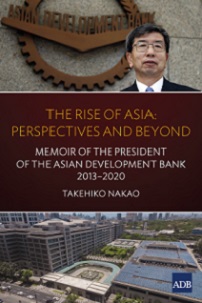 Book review: Takehiko Nakao, The Rise of Asia: Perspectives and Beyond. Memoir of the President of the Asian Development Bank 2013–2020 (Asian Development Bank, 2022)
Book review: Takehiko Nakao, The Rise of Asia: Perspectives and Beyond. Memoir of the President of the Asian Development Bank 2013–2020 (Asian Development Bank, 2022)
In April 2013, just five months after Xi Jinping took office as general secretary of the Chinese Communist Party, Takehiko Nakao was appointed president of the Asian Development Bank (ADB). He served for seven years until January 2020, overseeing an intense period of change in Asia, dominated by China’s rapid and assertive rise under Xi’s leadership.
During his presidency, Nakao also had to deal with the emergence of new financial institutions that challenged the role of the Bretton Woods-led global financial architecture. In 2014, the five BRICS countries – Brazil, Russia, India, China and South Africa – established the New Development Bank, with its headquarters in Shanghai, and in 2016 China launched the Beijing-based Asian Infrastructure Investment Bank (AIIB). Both were intended as alternatives to the World Bank, ADB and other existing development banks. At the same time, Xi launched the Belt and Road Initiative (BRI), which has in less than a decade become the world’s largest – and most controversial – source of infrastructure finance.
Nakao starts with an account of his years at Japan’s Ministry of Finance immediately preceding his assignment to the ADB, as director-general of the International Bureau and, subsequently, vice minister of finance for international affairs. The latter position is frequently a stepping stone to the ADB presidency, which has so far always been held by a Japanese national. In 2011, one of Nakao’s less thankful tasks was explaining to his international counterparts the government’s large-scale intervention to stabilise the rapidly appreciating yen. While at the ministry, Nakao established a solid network of global contacts that would serve him well at the ADB.
Recounting his time at the ADB, Nakao describes the day-to-day running of the president’s office, the internal workings of the ADB and how he interacted with the bank’s board of directors. Sections of the book, which at first seem like a digression – on how to deal with the media, conduct effective conference calls and draft joint statements at international meetings – are in fact useful for international financial professionals and not readily found elsewhere.

The most interesting chapters are on Nakao’s engagement with China, including the establishment of the AIIB and the BRI. Nakao provides details of his discussions with three successive finance ministers as well as other senior officials, including Vice Premier Liu He, Xi’s closest economic adviser. Over the years, Nakao and his colleagues at the ADB have provided China with consistent and sound economic advice, but with Xi’s growing emphasis on party and state control, it is not clear how much impact this has had.
Nakao’s account of the establishment of the AIIB sheds significant light on the political tensions underlying international financial cooperation in Asia. When China decided to launch the AIIB, the United States, Japan and most other Western countries were openly sceptical. However, as the initiative gained momentum, the Chinese were able to win over a growing number of non-regional countries. The dam burst on 12 March 2015 when the United Kingdom announced its decision to join the AIIB, followed within weeks by the rest of the European Union. Of the Western countries, only the United States and Japan currently remain outside the AIIB.
Consistent with the line pursued by Japan’s Ministry of Finance, Nakao initially questioned the need for a new development bank and whether it could meet established standards of transparency and due diligence. However, he eventually agreed that the ADB could help the AIIB get off the ground by jointly financing some of its projects. In his memoirs, Nakao comes across as more supportive of the AIIB than in a controversial interview published by the Financial Times in April 2015.
To his credit, Nakao supervised a merging of the ADB’s ordinary capital resources and its “soft” Asian Development Fund, consolidating the bank’s capital base and significantly increasing its lending capacity. He also introduced changes in personnel policy, although changes in the pension scheme have proved less than popular among new recruits.
Nakao concludes The Rise of Asia: Perspective and Beyond with his personal reflections on topics including the management of exchange rates and what other countries can learn from Asia’s development. He acknowledges Asia’s political and economic challenges but remains guardedly optimistic about the region’s future.
Since it was established in 1966, the ADB has had ten presidents, including the incumbent, Masatsugu Asakawa. Several have published their memoirs in Japanese, however those in English are few and far between. The bank’s first president, Takeshi Watanabe, published Towards a New Asia in 1977; and an informal translation of the memoirs of the fourth president, Masao Fujioka, exists but is not readily available. Nakao’s memoirs make a valuable contribution to the literature on the multilateral financial institutions and add depth to our understanding of the ADB and the fraught politics underlying development finance in Asia.

